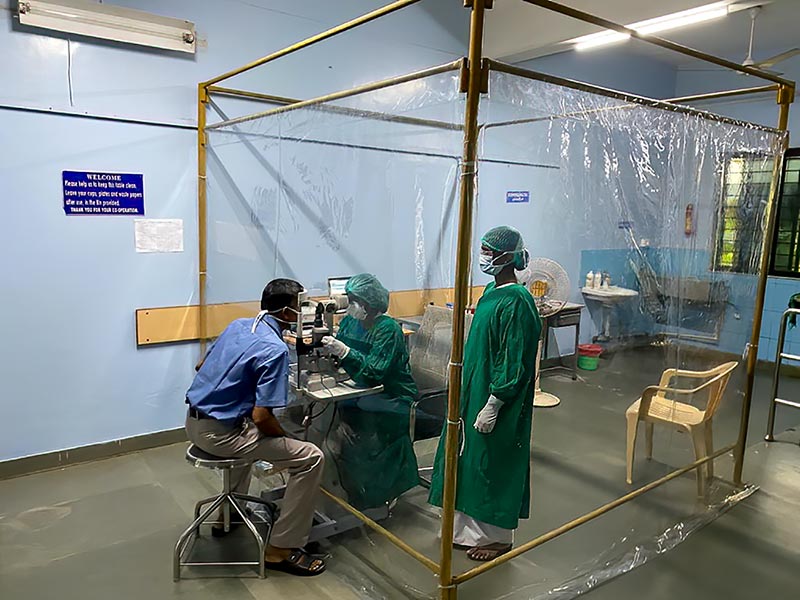Test your knowledge and understanding

Related content
This page is designed to help you to test your own understanding of the concepts covered in this issue, and to reflect on what you have learnt.
We hope that you will also discuss the questions with your colleagues and other members of the eye care team, perhaps in a journal club. To complete the activities online – and get instant feedback – please visit www.cehjournal.org
Tick ALL that are TRUE
Question 1
Consider clinic layout, triage, patient flow and basic safety when there are many people with COVID-19 in the area or country. Which statements are TRUE?
a. The number of consultations should be reduced to allow a distance of 1–2 metres between patients in waiting areas
b. It is important that all patients who come to an eye unit get a full clinical assessment
c. Investigations such as visual field assessment and OCT scans should only be performed when considered highly important
d. Routine, non-urgent work should be postponed or deferred
e. Checking the temperature of patients on arrival to a unit may help to identify patients with COVID-19
Question 2
Consider personal protective equipment and hand washing. Which statements are TRUE?
a. PPE removes all risk of SARS-CoV-2 infection
b. Putting on and taking off PPE correctly is as important as which type of PPE is used
c. Using hand sanitiser or hand rub can replace hand washing in hospital
d. Proper use of PPE removes the need to use hand rub or wash hands
e. Facial hair, such as beards may need to be removed to get a good seal when using a filtering face piece respirator mask (FFP mask)
Question 3
People with disabilities require extra care and support during the pandemic. Which statements are TRUE?
a. One of the main reasons why people with disabilities develop mental health problems is the stigma, discrimination and social exclusion they experience from people around them
b. Face masks may intimidate some patients and impede communication, so an extra effort may need to be made
c. If patients with disabilities have difficulty keeping to COVID-19 guidance then they should not be seen, even if they present with an emergency eye condition
d. Most people who become infected with SARS-CoV-2 are symptomatic and many become severely ill
e. Some people with cognitive disabilities cannot avoid touching their eyes
Question 4
Which statements are TRUE?
a. The excess mortality refers to the increased number of deaths from COVID-19
b. Eye care workers need to consider their own mental health during what may be a very stressful situation
c. Testing everyone admitted to hospital for COVID-19 is a useful way of finding out how many people in the country are infected
d. Most people who become infected with SARS-CoV-2 are symptomatic and many become severely ill
e. When there are many people infected with the SARS-CoV-2 virus, it is important to close all eye care services to stop the spread of infection
ANSWERS
1. a, c, d, and e are true. b. When there is a high level of infection in the community, consider deferring patients with non-urgent eye conditions or seeing patients by video or telephone consultation; this will reduce the risk of spreading the SARS-CoV-2 virus.
2. b and e are true. a. PPE can help reduce the spread of infection but does not remove all risk. c. If hands are visibly dirty, wash them with soap and water first.
3. a, b, d, and e are true. c. Patients who struggle to keep to COVID-19 guidance due to physical or mental disabilities should be given the support they need to be safe.
4. b is true. a. Excess mortality is the increase in the number of deaths (of any cause) compared to the number in a similar period in previous years. c. Testing only those people who come to hospital will give an inaccurate picture: many people can be positive for COVID-19 without showing any symptoms, and some may avoid coming to hospital due to transport difficulties or fear about contracting the virus. e. It is important that we help stop patients going blind, even during COVID-19. Patients with serious eye conditions, which may be vision or even life threatening, should still be seen.

